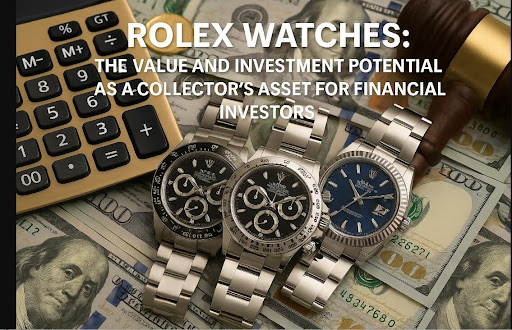Rolex is a name synonymous with luxury, prestige, and craftsmanship. Yet, over the years, this iconic brand has transcended its role as a mere timepiece maker. Today, Rolex watches are not only coveted for their elegance and style, but they also represent a unique opportunity for investors. They are considered by many as not just objects of desire but tangible assets with strong potential for value retention and appreciation. In this article, we’ll explore how Rolex has carved out a spot in the world of investment, offering insights into the brand’s market dominance, its long-term investment appeal, and the emerging trends that may further boost its financial allure. According to the Rolex Watch Market Report 2024, Rolex watches have consistently performed well in terms of investment returns.
Rolex’s Market Position: Scarcity, Demand, and the Luxury Factor
A Brand Steeped in History and Excellence
Founded in 1905 by Hans Wilsdorf and Alfred Davis, Rolex quickly established itself as a pioneer in the watch industry. The company’s dedication to precision, quality, and innovation led to groundbreaking inventions like the first waterproof wristwatch (the Oyster) and the first self-winding movement (the Perpetual). Today, it’s widely regarded as one of the world’s most prestigious brands, not just among horology enthusiasts but also among investors. The iconic status of a Rolex watch is almost unmatched, with the brand’s reputation being a key driver of its value. According to businessinsider pre-owned watch data, Rolex models have proven to be smart investments due to their strong value retention.
The Power of Scarcity and High Demand
What sets Rolex apart in the luxury market is its ability to control scarcity. Unlike many other high-end brands, Rolex deliberately limits the number of timepieces it produces each year. This strategy ensures that demand far outpaces supply, which in turn, boosts the desirability and price of its watches. Models like the Submariner, Daytona, and Day-Date are frequently seen fetching prices well above retail in the secondary market. Such controlled scarcity adds an air of exclusivity, making Rolex not only a status symbol but also an object of investment. For more information about buying Rolex watches, visit koniguhren.
The Investment Potential of Rolex: More Than Just a Luxury Item
Value Retention and Historical Appreciation
Rolex watches have long been known for their ability to retain value, and in many cases, appreciate over time. Some models have increased in value by over 10 times their original retail price. Take, for example, the vintage Rolex Daytona. This iconic chronograph has made headlines not just for its technical prowess but for its astronomical auction prices. In 2017, a Paul Newman Daytona fetched an astounding $17.8 million at a Phillips auction. This is just one of many examples of Rolex’s dominance in the auction world, where certain models have broken records and set new benchmarks for collectible assets.
A Success Story in the Auction World
Beyond retail price growth, Rolex watches have become legendary at auction houses. The Rolex Paul Newman Daytona is arguably the most famous example, with its price skyrocketing due to its rarity and historical significance. Other models, such as the GMT-Master II and Submariner, have also demonstrated significant value increases in the secondary market. For collectors and investors, Rolex represents a safe bet that combines aesthetic enjoyment with financial growth.
Comparing Rolex to Traditional Investments: Stocks, Real Estate, and More
Stability in Uncertain Times
While stocks are known for their volatility and real estate often requires hefty upfront capital, Rolex watches offer a different kind of stability. One of the key attractions for investors is the ability of Rolex timepieces to appreciate during uncertain economic periods. Unlike stocks, which can fluctuate with market trends, or real estate, which can be stymied by economic downturns, Rolex watches tend to hold their value or even increase in times of crisis. According to a 2024 study by the Swiss Watch Review, luxury watches, including Rolex, have outpaced inflation in the last two decades, making them a reliable hedge against financial instability.
A Portable Asset
One of the most distinctive advantages of investing in Rolex watches is their portability. Unlike real estate, which requires a significant physical footprint and liquidity challenges, or stocks, which are confined to digital platforms, a Rolex watch is a tangible, wearable asset. This gives it an added layer of appeal for high-net-worth individuals seeking to diversify their portfolios.
The Role of Rolex in a Diversified Investment Portfolio
A Unique Financial Safeguard
Including Rolex watches in an investment portfolio can offer more than just potential profit. While they provide aesthetic enjoyment, they also serve as a financial safeguard. In fact, many investors consider them a form of “alternative investment.” With the increasing interest in diversifying away from traditional asset classes like stocks and bonds, Rolex watches provide a valuable alternative. They combine timeless appeal with modern wealth-building strategies, especially for younger generations looking to blend tradition with innovative financial growth.
Emerging Markets and Younger Demographics
As emerging markets continue to grow, and as younger, affluent buyers show increasing interest in luxury items as investments, Rolex watches are poised to benefit. This growing appeal, particularly in regions like China, India, and the Middle East, may push demand even higher, solidifying Rolex’s position in the market for years to come.
The Future of Rolex as an Investment: Trends and Technology
The Rise of Digital Ownership: NFTs and Blockchain
Looking ahead, the future of Rolex as an investment may not only lie in its physical watches but in their digital counterparts. With the rise of blockchain technology and NFTs (Non-Fungible Tokens), Rolex could explore offering digital certificates of authenticity for its timepieces. This would provide buyers with a secure, verifiable form of ownership that adds an additional layer of transparency and trust. According to 2024 Watch Industry Insights, luxury brands are increasingly adopting blockchain solutions to track provenance and ownership, further enhancing the appeal of Rolex watches in the digital age.
Potential for Continued Growth
Given the brand’s enduring appeal, the limited production of models, and the growing interest from younger buyers, Rolex watches are likely to continue to see strong appreciation in the coming years. Watches such as the Cosmograph Daytona, GMT-Master, and President Day-Date models have all been highlighted as potential future stars in terms of investment returns. As the brand expands its presence in emerging markets and continues to attract younger, tech-savvy buyers, the future of Rolex as both a luxury item and a financial asset looks promising.
Conclusion: Rolex Watches – More Than Just a Luxury Purchase
In summary, Rolex watches are no longer simply luxury accessories, but have become valuable financial assets in their own right. Whether for their historical value, consistent appreciation, or their status as a portable investment, Rolex timepieces offer unique advantages over traditional asset classes like stocks and real estate. With the brand’s continued innovation and its potential for digital transformation through blockchain technology, Rolex watches will likely remain a staple in investment portfolios for years to come. For those seeking a blend of wealth preservation and growth, Rolex watches stand out as a timeless choice.
FAQ: Frequently Asked Questions
Q1: Why are Rolex watches considered an investment?
A1: Rolex watches are known for their exceptional craftsmanship and brand reputation, which allow them to retain value in the market and even appreciate over time. Many classic models, such as the Rolex Paul Newman Daytona, have proven their potential for massive value increases in the auction market. Additionally, Rolex’s limited production and high demand also push prices up in the secondary market.
Q2: Why are Rolex watches more attractive as investments compared to other luxury goods?
A2: Rolex watches aren’t just luxury items; they are investments with unique characteristics that other assets don’t offer. Unlike the volatility of stocks and the high capital requirements of real estate, Rolex watches are a relatively stable and portable investment option. Especially in times of economic uncertainty, Rolex watches have consistently maintained or increased in value.
Q3: Which Rolex models are the best for investment?
A3: Iconic Rolex models like the Submariner, Daytona, and GMT-Master II have consistently shown strong market demand and appreciation potential. Limited editions or vintage models, in particular, often perform well at auction, breaking records and offering substantial returns for investors.
Q4: How do blockchain and NFTs impact the future of Rolex watches as an investment?
A4: Blockchain and NFT technology are being adopted by more luxury brands, providing a new way to verify the authenticity of products. By offering digital certificates of authenticity, Rolex could provide buyers with a secure, transparent proof of ownership, which could further enhance trust and appeal for collectors and investors, potentially increasing the brand’s digital asset value.
Author: Alex Carter (Watch Writer)
Bio: Alex Carter writes about watches with a mix of curiosity and passion. From market trends to timeless designs, he enjoys sharing stories that help readers see watches as more than just tools for telling time.





























